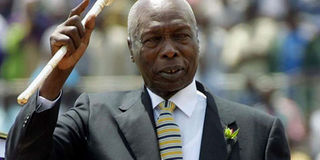Avoid the trap of false equivalence

Kenyan President Daniel Moi arrives at Nyayo National Stadium for Moi Day celebrations on October 10, 2001. Graft thrived during his tenure. PHOTO | PEDRO UGARTE | AFP
What you need to know:
- When the youth of Kenya are told to entrepreneur their way out of unemployment like other youth in western countries, it is a case of false equivalence.
- You’d underestimate the insidious damage done to institutions like media, education, art and music, human rights and freedoms as well as the economy during the 24 years of Moi rule.
False equivalence is a logical fallacy in which two incompatible arguments appear to be logically equivalent when in fact they are not.
It’s an argument that two things have the same weight, when each of these things is supported by varying and unequal factors.
False equivalence makes complex things seem simple and easy to interpret by lowering the need for critical thinking.
It’s based on anecdotal evidence, which dangerously distracts from real issues and clouds judgement, minimising the gravity of problems without offering any solutions.
For example, when the youth of Kenya are told to entrepreneur their way out of unemployment like other youth in western countries, it is a case of false equivalence.
Comparing youth purely on age and not on facts such as differences in economic environments of countries, access to funds, state of markets, political stability and so on, inhibits the issue of youth unemployment from being addressed.
MOI RULE
The argument that women seeking political or any other leadership positions should fight like men, when facts are that women can’t fight like men, do not have the same resources and the socio-cultural narrative does not favour them, is another case of false equivalence.
Those who peddle this narrative choose wilful ignorance when there’s extensive research unravelling what keeps women out of leadership.
A recent example is Nyayo Stadium being filled by mourners when Daniel Moi died.
The argument was that if indeed those who’d been doing the tedious work of teaching and speaking of an alternative mentally-free Kenya were successful, then Nyayo Stadium wouldn’t have been filled.
If you didn’t know the differences in contexts, facts and realities between these two cases, you’d also believe that this is true when it’s actually false.
You’d underestimate the insidious damage done to institutions like media, education, art and music, human rights and freedoms as well as the economy during the 24 years of Moi rule.
GROWTH INHIBITOR
You’d be blinded from seeing the consequences of the inherited dysfunctional system of governance. You’d assume that this culture can be wiped clean in a few years when the old culture has existed for over five decades.
Lastly, you’d easily think behavioural change is an event and dismiss the gains already being made even as the state machinery fights back.
It is thus disingenuous to mock the work being done by the various pockets of people trying to create a Kenyan consciousness especially when we are reminded daily that the cost of doing right in Kenya is so high.
The damage of false equivalence is so deep because it creates no room for real problem-solving.
The writer is a policy analyst. [email protected]





